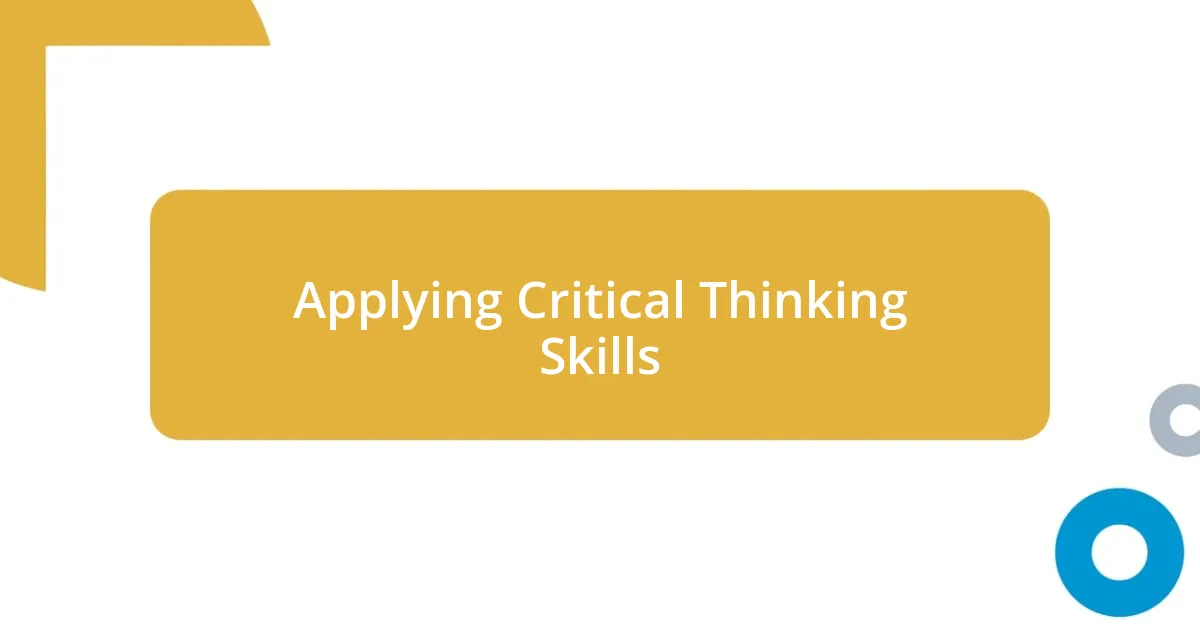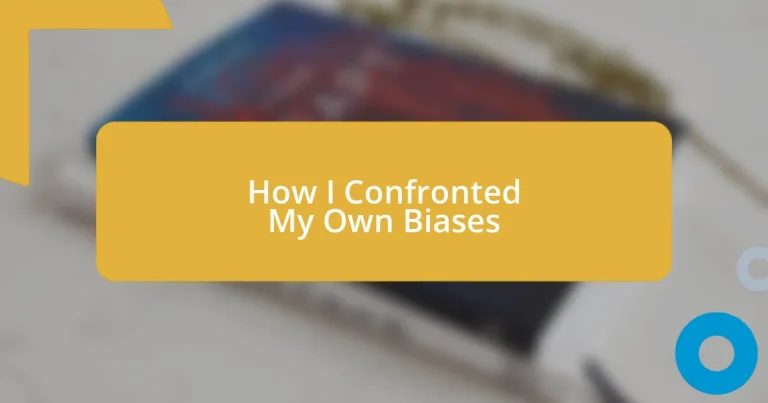Key takeaways:
- Understanding personal biases starts with self-reflection and acknowledging uncomfortable truths, often influenced by early experiences.
- Recognizing bias triggers involves identifying emotional responses and reflecting on language, stereotypes, and past experiences.
- Engaging in open conversations and practicing curiosity fosters deeper understanding and helps combat defensiveness.
- Applying critical thinking techniques, like the “5 Whys,” and seeking diverse perspectives enriches one’s worldview and promotes empathy.

Understanding Personal Biases
Understanding personal biases can be a challenging yet enlightening journey. I remember a time when I realized I had a preconceived notion about a particular group of people that stemmed from a childhood experience. It hit me hard: how often do our early influences shape our perceptions without our awareness?
I often ask myself, “What am I missing here?” This question has become a powerful tool for introspection. When I confronted my biases, I felt a wave of vulnerability wash over me. It was uncomfortable but crucial; it forced me to reevaluate my perspectives and the very foundations of my beliefs.
Delving into personal biases involves wrestling with uncomfortable truths. I found it liberating to acknowledge that my perspectives might be clouded by stereotypes. For instance, engaging in conversations with individuals from that group opened my eyes to their diverse experiences, which was honestly an enriching experience that allowed me to grow and transform my approach moving forward.

Recognizing Bias Triggers
Recognizing bias triggers has been quite the eye-opener for me. It often starts with a gut feeling or an emotional response to a situation. For example, I noticed that when I encountered certain opinions that contradicted my own, I would feel a sudden surge of defensiveness. That’s when I realized that these moments were not just about disagreement; they were revealing deeper biases ingrained within me.
To get more in tune with these triggers, I found it helpful to reflect on specific situations that led to strong emotional reactions. Here are some key triggers I identified:
- Language: Certain words or phrases can provoke instinctual responses.
- Cultural stereotypes: Media representations can shape how I view different groups.
- Past experiences: Previous interactions can create biases that color my current perceptions.
- Peer influence: Feedback from friends and family can subconsciously reinforce bias.
- Unfamiliarity: Encountering something or someone outside my norms can elicit discomfort.
Being aware of these triggers allows me to pause and question my instinctive reactions, leading to more thoughtful and open conversations.

Strategies for Self-Reflection
Reflecting on my biases has always required me to approach myself with patience and honesty. One method that’s been effective for me is journaling my thoughts and reactions throughout the day. Writing down specific moments where I felt biased has not only provided clarity but has also highlighted patterns over time that I previously might have overlooked. This ongoing dialogue with myself fosters a space for growth that I truly value.
Another strategy I’ve embraced is engaging in meaningful discussions with people who have different perspectives. I recall a lively debate I had with a friend about cultural representation in media. Our differing opinions challenged me to reconsider my views. These conversations create a rich environment for self-reflection, offering insights that often push me out of my comfort zone. I believe that openness to these dialogues is crucial for genuine self-growth.
Mindfulness practices have also played a significant role in my self-reflection journey. Practicing meditation allowed me to become more aware of my thoughts without immediately reacting to them. When I sit quietly, I can observe my biases as they arise, almost like watching waves ebb and flow. This helps me discern my automatic reactions, making it easier to respond thoughtfully rather than impulsively.
| Strategy | Description |
|---|---|
| Journaling | Writing about daily experiences helps identify and analyze biases over time. |
| Engaging Conversations | Talking with individuals from diverse viewpoints challenges assumptions and encourages self-reflection. |
| Mindfulness Practices | Meditation enhances awareness of biases, promoting a thoughtful response to automatic thoughts. |

Engaging in Open Conversations
Engaging in open conversations has been a transformative experience for me. I remember the first time I confronted my bias during a discussion about immigration policy. A friend shared their personal story, filled with challenges and resilience. It made me wonder—how often do I let real human experiences shape my views?
Through these dialogues, I’ve learned the importance of vulnerability. I once decided to share my own biases in a group setting. As I honestly communicated my feelings about a particular social issue, I felt a wave of relief wash over me. It struck me that admitting my biases not only fostered trust among us but also paved the way for more profound and authentic conversations.
I’ve also noticed that when I approach discussions with curiosity rather than defensiveness, the outcomes are often positive. There was a time when I engaged with a colleague who held entirely different beliefs than mine. Instead of shutting down, I asked questions, hoping to understand their viewpoint better. This curiosity turned the conversation into a rich exchange of ideas, leaving us both with a deeper understanding of each other. Isn’t it fascinating how challenging our own views can lead to unexpected insights?

Applying Critical Thinking Skills
Applying critical thinking skills has been a pivotal part of my journey in confronting biases. I vividly remember a moment in a class discussion about societal norms. I found myself instinctively dismissing a peer’s perspective until I paused to reflect. This shift—realizing I had an impulse to guard my beliefs—prompted me to question not just their viewpoint, but my own reluctance to engage fully. What if I’m missing out on valuable understanding because of my stubbornness?
One approach I’ve adopted is the “5 Whys” technique, where I dig deeper into my initial reactions. There was a time when I instinctively felt anger during a political debate. Instead of reacting right away, I asked myself why that anger surged. With each layer I peeled back, I uncovered fears about change and the unknown. This process of probing not only calms the immediate emotional response but also helps me resolve the underlying issues informing my biases.
I’ve found that incorporating a diverse range of materials into my learning process has expanded my worldview significantly. Reading books or articles from authors with different backgrounds has opened my eyes to experiences I had never considered before. After reading a memoir about a marginalized community, I felt a sense of empathy that reshaped my understanding of social issues. Isn’t it intriguing how a single story can challenge your entire perspective? Engaging with differing ideas and narratives not only sharpens my critical thinking but also inspires a genuine desire to evolve.

Seeking Diverse Perspectives
Seeking diverse perspectives has truly enriched my understanding of the world. I remember attending a cultural festival where I had the chance to engage with people from various backgrounds. Listening to their stories was an eye-opener; their experiences were so different from mine, yet their emotions were universally relatable. It made me realize just how much I had overlooked in my own community.
I’ve also found that attending panels and discussions featuring diverse voices adds layers to my perspective. There was one event where an activist spoke passionately about systemic injustices. Their raw emotion and fierce dedication opened my eyes to issues I had only brushed the surface of. After that experience, I couldn’t help but ask myself—how could I remain indifferent when there’s so much depth to explore?
Engaging with diverse perspectives doesn’t just challenge my beliefs; it invites growth. For instance, after forming a reading group centered around literature from various cultural authors, I discovered themes of resilience and struggle that reflected commonality across our differences. Have you ever felt that sense of connection despite the varying backgrounds? It’s a powerful reminder that every narrative carries a lesson, waiting to be embraced.














